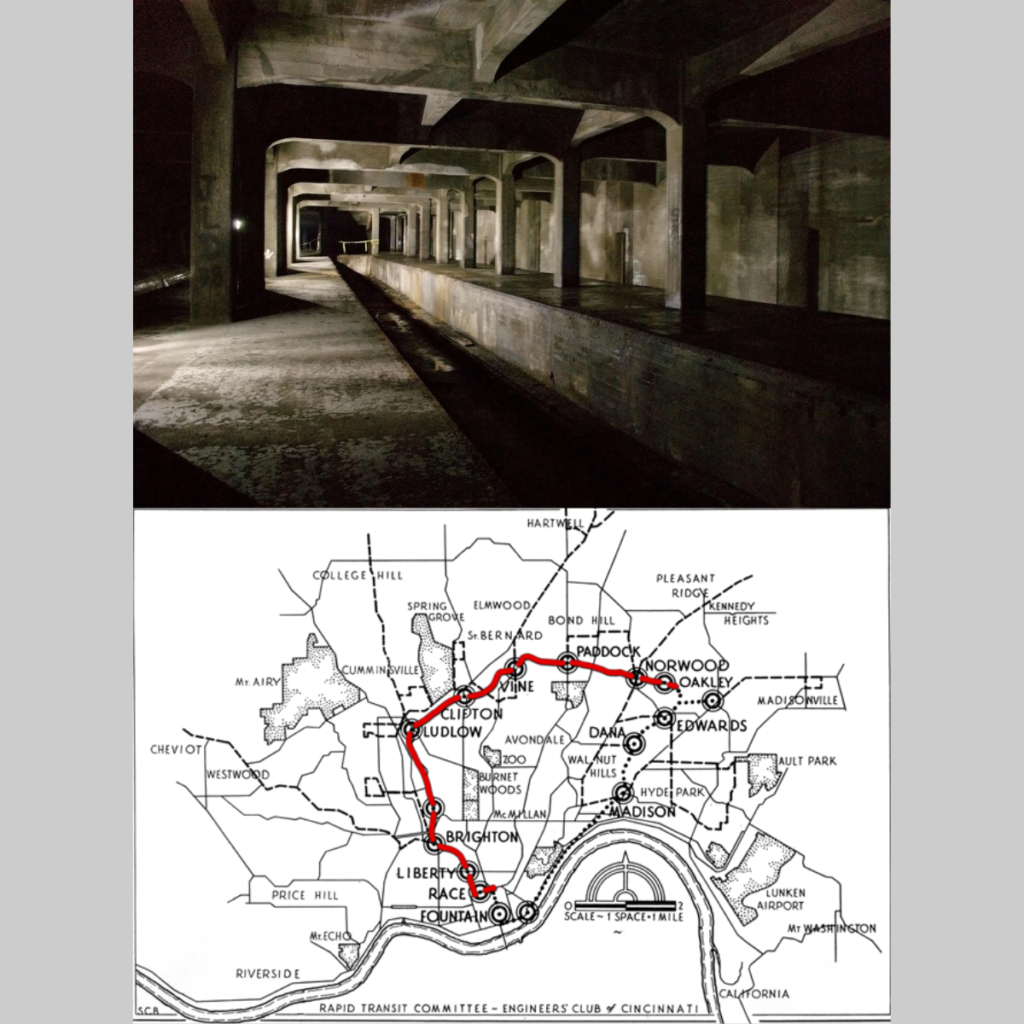
Over in America, there are decaying underground spaces on a huge scale, as well.
This Cincinnati Transit site documents all the structures and stations of this unfinished subway transit system, built from 1920 to 1925. Fully seven miles of tunnels, bridges and stations were abandoned in the end, no track was ever put in, and no passengers ever rode the trains.
Three underground stations still exist, but the above-ground structures were demolished, leaving only a few barely-visible access points into the vast underground territory.
One such entry point:
Map of a hidden subway line (one of many):
A similar tunnel system (but build in the 70s) runs underneath downtown core in the city of Calgary, Canada. The LRT (Light Transit System) line was meant to run underground, but the plans were shelved for the financial reasons. There are a few doors in Calgary leading to this explorer’s playground, to tunnels wide enough for rush hour traffic.
IN THE EARLY YEARS OF the twentieth century, when the river trade was flourishing and it ranked in the top ten largest cities in the nation, Cincinnati decided to build a subway system. The major impetus was the draining of the Miami and Erie Canal, along which the subway would be built.
The idea really originated in 1884, when the Cincinnati Graphic printed an illustration showing trains chugging along underground, in an old canal bed covered with a new street.
After their remarkably brief golden era, canals quickly became even more of a nuisance than they had been when they were bringing in trade. Many were partially drained; whatever water there was ended up breeding mosquitoes and disease. The muddy canal bottoms were used as refuse dumps. Since the Miami & Erie cut right through the heart of the city, it was a particular eyesore in Cincinnati.
The plan was made in 1912 to build a sixteen-mile rapid transit rail system in a loop around the city, with a branch going underground and heading downtown. It surfaced at Brighton and Saint Bernard and ran above ground along the Ohio River.
The cost, originally estimated at $12 million, was cut to $6 million and then voted on in 1916. More than 80% of Cincinnatians said yes to the new railway, but work wasn’t begun until after World War One–January 28, 1920. Ground was first broken on Walnut Street where nowadays you will find office buildings, apartments, and restaurants.
Despite several delays, the two-mile underground portion of the subway was completed by 1923. Inflation had destroyed the projected budget and caused the rail loop to be reduced in size.
In 1926 Mayor Murray Seasongood took control of the transit project from the county and gave it to the city, then estimated another $10 million needed to be spent to see it through to completion. Central Parkway, which was built atop the underground tunnels, opened in 1928, and that seemed to be all the transit Cincinnati residents wanted at the time, especially with such a steep price tag for finishing the project.
Of course, in 1929 any consideration of paying the millions evaporated when the stock market crashed and the country plunged into the dark depths of the Great Depression. Proposals came and went in the 30s, but none were implemented. One idea was to run trolleys through the tunnels, but the trolley cars were too long for the subway’s bends. Another proposal, made by City Manager C.O. Sherrill in 1939, was to use them for automobile traffic, but the cost of the plan was too high.
A 1948 study finally mothballed the Cincinnati Subway for good, though efforts to do something with the tunnels have been constantly ongoing for more than half a century. Ideas have included a bomb shelter, a shopping and nightlife district, a massive wine cellar, and more rapid transit. The latest proposal is for another subway. I-75 was built, destroying a large segment of the underground passage. But one of the Queen City’s best-kept secrets is the fact that sections of the original subway still remain–including all four of the stations put in during initial construction.




